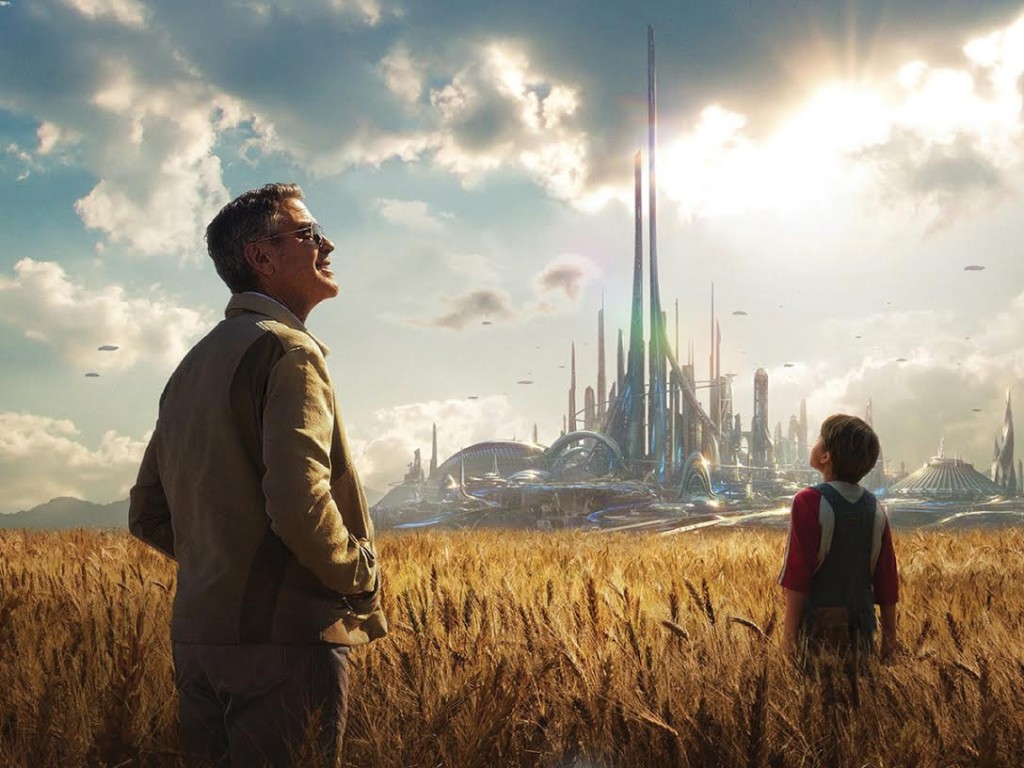
“Tomorrowland” takes a few Disneyland references and slaps them onto the background of a film that otherwise does not feel like a Disney movie. Brad Bird, known for his experiences in both writing and directing “Ratatouille” and “The Incredibles,” takes viewers on a ride through space and time to a reimagined city-sized version of Disneyland’s future-themed area of the same name. While “Tomorrowland” is likely to hold the interest of young children, most moviegoers are bound to find themselves spending more time critiquing the film’s flaws than enjoying its (sometimes) great special effects, the occasional presence of acting talent and interesting message about pessimism in modern media.
“Tomorrowland” introduces the story of Frank Walker (Thomas Robinson), a dreamer hoping to put his newest invention on display at New York’s World Fair in 1964. After being ridiculed for his not-very-functional invention, he is greeted by a young girl (Raffey Cassidy) who leads him to the incredibly advanced city of the future: Tomorrowland. 50 years pass before Casey Newton (Britt Robinson), the daughter of a NASA engineer, does everything in her power to prevent a nearby launch site, her father’s place of employment, from being disassembled. She too manages to happen upon Tomorrowland, and soon finds that the last hope for humanity’s survival lies in her, the aged Frank Walker (George Clooney) and the city of Tomorrowland itself.
The main drawing factor of this film is undoubtedly its connection to Disneyland’s themed attraction area of the same name, and as a result people may have expectations of a storyline rich with references to the source material. During my first viewing of the film, “Tomorrowland” made a total of three noticeable references to Disneyland’s Tomorrowland area: Space Mountain can be seen in the background of a few scenes but is never mentioned in dialogue, the monorail maglev train modeled after the real life transit option at Disneyland theme parks is ridden by the main character Newton in one scene and the Tomorrowland pins are marked with the recognizable “T” logo seen at Disney theme parks. That’s it. This film could have omitted every one of its Disney-themed references, been renamed “Futureplace” and would have remained largely unchanged. If you are excited to see this movie because of its ties to the Disney brand, you will leave mostly disappointed.
I say mostly, because “Tomorrowland” does have its redeeming qualities. For example, the city of Tomorrowland is beautifully rendered in CGI; its large abstractly shaped buildings, bright reflective surfaces and levitating vehicles accurately represent the city of tomorrow that Walt Disney himself once envisioned. In addition to some great environments, the CGI effects used during most of the action scenes were well done, and to a certain extent, believable. Where computer-generated qualities should have excelled but instead fell short was in the creation of human models. In multiple scenes (including early scenes with young Frank Walker), the CGI rendering of human models seemed … off. There was a very inhuman, ragdoll-esque form that human characters took when they were switched from physical to CGI-rendered representation on-screen. This was extremely distracting, and completely pulled me out of a few otherwise immersive action scenes.
The greatest ailments of “Tomorrowland” are its script and many of its acting performances. Most of the supporting cast, including one of the two main characters (hint: it’s not Clooney) give lackluster performances, with some pretty cringe-worthy line delivery. The actors aren’t completely at fault though, as large portions of the script are just poorly-written or miss the mark (Clooney and Robertson arguing as narrators to their story, on two separate occasions, being one un-funny example of many).
The high points of the film’s acting were without a doubt provided by Clooney as the aged Frank Walker, Keegan-Michael Key as his character Hugo the futuristic memorabilia shop owner and Hugh Laurie as Nix, the mayor of Tomorrowland. Clooney, who had only less poorly-written dialogue to work with compared to his female counterpart, made the best of what he was given, and managed to bring a livelihood to the screen where his supporting cast consistently fumbled. The most emotionally powerful scenes in the film were those led by Clooney himself, in contrast to Cassidy’s Athena.
The high point of the film’s humor was Keegan-Michael Key’s character introduction. He literally walks into the room with dreads and an obviously fake overhanging belly, gets half stuck in the door and says a few words. Dr. House’s performance as a British mayor of a futuristic city was also fantastic. His speech near the end of the film on humanity’s failure to heed the warnings of Earth’s imminent end was easily the most well-written and performed piece of dialogue in the entire film.
“Tomorrowland” isn’t an entirely boring film. It isn’t terribly unpleasant, and there’s a good chance most people will find something they enjoyed. Unless you have some disposable income, two hours and ten minutes to burn and you’ve already seen “Mad Max: Fury Road” and “Avengers: Age of Ultron,” you might be better off waiting for this one to hit Netflix.
Rating: 2.5 stars








